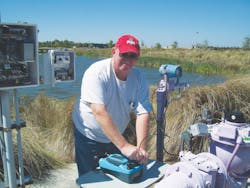Kim Anderson is product manager, processing and calibration, for FasTest. Anderson can be reached at [email protected] or 651.251.9741.
The Brevard County (Fla.) Utility Services Department (USD) administers the county’s water and wastewater programs—providing drinking water treatment and distribution services, wastewater collection and treatment services, and delivery of reclaimed water in numerous areas throughout the county. To provide these critical services, the department uses pressure transmitters to monitor and maintain the appropriate pressure in numerous systems.
Pressure transmitters must be calibrated regularly to ensure accurate performance. The calibration process traditionally requires connections to be made through the use of wrenches, a great deal of torque and significant amounts of valuable time. The Brevard County USD, however, accelerates this process by making leak-tight, wrench-free connections with connectors from FasTest Inc. in Roseville, Minn.
Pressure Transmitters
Pressure transmitters are used as the process variable controlled by programmable logic controllers to maintain the appropriate pressure set points in water and reclaimed water distribution systems. The accurate measurement of water and reclaimed water line pressures provided by these transmitters ensures adequate water pressure to the end-users, while preventing damage to the distribution lines.
Pressure transmitters also are used to monitor force main pressures in wastewater collection systems, as well as the levels of water and reclaimed water in storage tanks. In level applications, the measured pressure is converted electronically to equal the level in the tank. Accurate measurement of tank levels allows proper management of water and reclaimed water supplies. Additionally, pressure transmitters are used to monitor the pressure in monitor wells. They are placed above deepwells, in which treated wastewater not used for reclamation is discharged.
“Semi-annual or annual pressure transmitter calibration is required to meet various regulatory, permitting and operational needs, depending on the application,” said Guy Spring, SCADA technician at the Brevard County USD.
Calibration Situation
In the past year, the Brevard County USD made the switch from outsourcing instrument calibration from an outside contractor to calibrating instruments in house in an effort to reduce costs.
“In starting to perform these in-house calibrations, it became quite evident early on that the hoses and fittings provided with the pressure calibrator were inadequate and inefficient,” Spring said. “They required tape and wrenches, which did not guarantee a proper seal to accurately perform the calibration.”
To increase calibration reliability and efficiency, the Brevard County USD purchased hose assemblies, vent plug adapters and swivel connectors to connect its pressure calibrator to the various pressure transmitters. The connectors are designed to speed calibration procedures by improving productivity, quality and safety. A unique twist-to-connect and pressure-assisted grip-and-seal design allows fast, safe and repeatable threaded connections, eliminating thread wear and damage common to traditional connectors.
“The FasTest equipment allows us to quickly, easily and accurately calibrate many different models of transmitters,” Spring said.
The calibration process consists of disconnecting the supply inlet to the pressure transmitter, connecting the pressure calibrator to the same inlet and checking the instrument milliamp output while increasing pressure across the full scale of the instrument with the pressure calibrator pump.
“The biggest advantage of the FasTest equipment is achieving a quick connection every time,” Spring said. “This definitely saves time, as our department has [more than] 45 different pressure transmitters. The reduction in calibration time required is easily a 50% difference.”
Along with efficiency, the new products allow greater reliability. Traditional sealing methods pair mating thread profiles with a thread sealant (e.g., tape). The thread sealant, in conjunction with the interference fit and a great deal of torque—typically applied with a wrench—changes the dimensions of the profiles. If the connection is not leak-tight, it may result in a hazardous situation. Each time a connection is taped and torqued to seal, wear or damage occurs to the thread profiles, making it more difficult to achieve leak-tight connections in the future.
“The other big advantage is increased accuracy,” Spring said. “Reliable connections remove errors in the calibration process, while allowing a procedure that remains standard from instrument to instrument.”
The speed and reliability of the new equipment allowed the Brevard County USD to perform pressure transmitter calibration efficiently and accurately in house, and FasTest personnel facilitated the transition.
“[The] personnel were extremely helpful in ensuring the correct equipment was purchased, while also performing follow-up checks to ensure the equipment worked as advertised,” Spring said. “Their help in this matter was invaluable to our efforts of performing our own in-house calibrations.”
Download: Here


